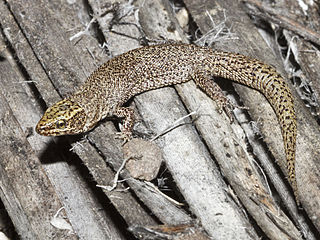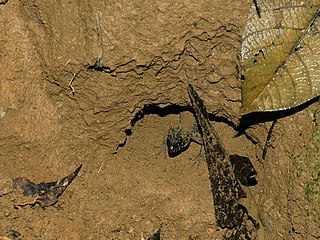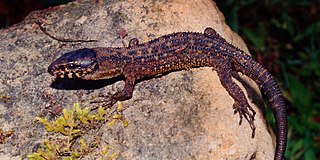
Asexual reproduction is a type of reproduction that does not involve the fusion of gametes or change in the number of chromosomes. The offspring that arise by asexual reproduction from either unicellular or multicellular organisms inherit the full set of genes of their single parent and thus the newly created individual is genetically and physically similar to the parent or an exact clone of the parent. Asexual reproduction is the primary form of reproduction for single-celled organisms such as archaea and bacteria. Many eukaryotic organisms including plants, animals, and fungi can also reproduce asexually. In vertebrates, the most common form of asexual reproduction is parthenogenesis, which is typically used as an alternative to sexual reproduction in times when reproductive opportunities are limited. Some monitor lizards, including Komodo dragons, can reproduce asexually.

Lepidophyma is a genus of lizards, commonly called tropical night lizards. The genus Lepidophyma is one of three genera of night lizards, which are a group of viviparous (live-bearing) lizards. There are 20 species of tropical night lizards in the genus Lepidophyma, making it the most populous night lizard genus. Species of the genus Lepidophyma are distributed throughout Central America, found anywhere from central Mexico to Panama, depending on the particular species. Tropical night lizards, particularly the yellow-spotted species, are sometimes called Central American bark lizards by pet dealers and owners.

The desert night lizard is a night lizard native to the Southern California Eastern Sierra and the San Gabriel Mountains into Baja California, southern Nevada, southwestern Utah and extreme western areas of Arizona.

Thelytoky is a type of parthenogenesis and is the absence of mating and subsequent production of all female diploid offspring as for example in aphids. Thelytokous parthenogenesis is rare among animals and reported in about 1,500 species, about 1 in 1000 of described animal species, according to a 1984 study. It is more common in invertebrates, like arthropods, but it can occur in vertebrates, including salamanders, fish, and reptiles such as some whiptail lizards.

Parthenogenesis is a natural form of asexual reproduction in which the embryo develops directly from an egg without need for fertilization. In animals, parthenogenesis means development of an embryo from an unfertilized egg cell. In plants, parthenogenesis is a component process of apomixis. In algae, parthenogenesis can mean the development of an embryo from either an individual sperm or an individual egg.

The yellow-spotted tropical night lizard or yellow-spotted night lizard is a species of night lizard. The species is distributed from central Mexico, through Central America, south to Panama. It includes two subspecies.

Nauphoeta cinerea, the speckled cockroach, lobster cockroach, or (small) cinereous cockroach, is a species of cockroach in the family Blaberidae. It is the sole species in the genus Nauphoeta.
Parthenogenesis is a mode of asexual reproduction in which offspring are produced by females without the genetic contribution of a male. Among all the sexual vertebrates, the only examples of true parthenogenesis, in which all-female populations reproduce without the involvement of males, are found in squamate reptiles. There are about 50 species of lizard and 1 species of snake that reproduce solely through parthenogenesis. It is unknown how many sexually reproducing species are also capable of parthenogenesis in the absence of males, but recent research has revealed that this ability is widespread among squamates.
Lepidophyma chicoasensis, the Sumidero tropical night lizard, is a species of lizard in the family Xantusiidae. It is a small lizard found in Sumidero Canyon in Chiapas, Mexico, at 600 meters elevation.
Lepidophyma dontomasi, MacDougall's tropical night lizard, is a species of lizard in the family Xantusiidae. It is a small lizard found in Mexico. It is known only from the type locality on Cerro Lachiguiri in Oaxaca state, where it was collected at 2200 meters elevation. It may be more widespread.
Lepidophyma lineri, Liner's tropical night lizard, is a species of lizard in the family Xantusiidae. It is a small lizard found in Mexico. It is native to the Sierra de Miahuatlán, a sub-range of the Sierra Madre del Sur in south-central Oaxaca.
Lepidophyma lipetzi, Lipetz's tropical night lizard, is a species of lizard in the family Xantusiidae. It is a small lizard found in Mexico.
Lepidophyma lowei, Lowe's tropical night lizard, is a species of lizard in the family Xantusiidae. It is a small lizard found in Mexico. It is known only from San Bartolome Zoogocho, in Zoogocho Municipality, in the Sierra Madre de Oaxaca of Oaxaca state at 2,200 meters (7,200 ft) elevation.
Lepidophyma mayae, the Mayan tropical night lizard, is a species of lizard in the family Xantusiidae. It is a small lizard found in Mexico, Honduras, Guatemala, and Belize.
Lepidophyma micropholis, the cave tropical night lizard, is a species of lizard in the family Xantusiidae. It is a small lizard found in Mexico. It is native to caves in the Sierra del Abra Tanchipa, part of the Sierra Madre Oriental in eastern San Luis Potosí and adjacent southern Tamaulipas states.
Lepidophyma occulor, the Japlan tropical night lizard, is a species of lizard in the family Xantusiidae. It is a small lizard found in Mexico. This species is native to the Valle de Jalpan in the Sierra Madre Oriental of northern Querétaro and adjacent San Luis Potosí states, from 900 to 1,400 meters elevation.
Lepidophyma pajapanensis, the Pajapan tropical night lizard, is a species of lizard in the family Xantusiidae. It is a small lizard found in Mexico. It is native to the coastal Sierra de los Tuxtlas, and to the southeast near Jesús Carranza on the Coatzacoalcos River in the Isthmus of Tehuantepec. It ranges from sea level up to 1,500 meters elevation.

Lepidophyma reticulatum, the Costa Rican tropical night lizard, is a species of lizard in the family Xantusiidae. It is a small lizard found in Costa Rica and Panama.

Lepidophyma sylvaticum, the Madrean tropical night lizard, is a species of lizard in the family Xantusiidae. It is a small lizard found in Mexico.








